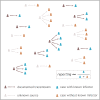Measuring the unknown: An estimator and simulation study for assessing case reporting during epidemics
- PMID: 35604952
- PMCID: PMC9166360
- DOI: 10.1371/journal.pcbi.1008800
Measuring the unknown: An estimator and simulation study for assessing case reporting during epidemics
Abstract
The fraction of cases reported, known as 'reporting', is a key performance indicator in an outbreak response, and an essential factor to consider when modelling epidemics and assessing their impact on populations. Unfortunately, its estimation is inherently difficult, as it relates to the part of an epidemic which is, by definition, not observed. We introduce a simple statistical method for estimating reporting, initially developed for the response to Ebola in Eastern Democratic Republic of the Congo (DRC), 2018-2020. This approach uses transmission chain data typically gathered through case investigation and contact tracing, and uses the proportion of investigated cases with a known, reported infector as a proxy for reporting. Using simulated epidemics, we study how this method performs for different outbreak sizes and reporting levels. Results suggest that our method has low bias, reasonable precision, and despite sub-optimal coverage, usually provides estimates within close range (5-10%) of the true value. Being fast and simple, this method could be useful for estimating reporting in real-time in settings where person-to-person transmission is the main driver of the epidemic, and where case investigation is routinely performed as part of surveillance and contact tracing activities.
Conflict of interest statement
The authors have declared that no competing interests exist.
Figures




References
-
- Polonsky JA, Baidjoe A, Kamvar ZN, Cori A, Durski K, John Edmunds W, et al.. Outbreak analytics: a developing data science for informing the response to emerging pathogens. Philosophical Transactions of the Royal Society B: Biological Sciences. 2019. p. 20180276. doi: 10.1098/rstb.2018.0276 - DOI - PMC - PubMed
-
- Meltzer MI, Atkins CY, Santibanez S, Knust B, Petersen BW, Ervin ED, et al.. Estimating the future number of cases in the Ebola epidemic—Liberia and Sierra Leone, 2014–2015. MMWR Suppl. 2014;63: 1–14. - PubMed
-
- World Health Organisation (WHO). Guinea: The Ebola Virus Shows its Tenacity. In: WHO [Internet]. 2015 [cited 20 Jan 2020]. Available: https://www.who.int/csr/disease/ebola/one-year-report/guinea/en/.
Publication types
MeSH terms
Grants and funding
LinkOut - more resources
Full Text Sources
Medical

